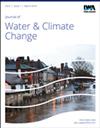岷江水情演变及生态响应分析
IF 3.1
4区 环境科学与生态学
Q2 WATER RESOURCES
引用次数: 0
摘要
摘要水文状态的自然波动是维持河流生态系统功能的关键。针对岷江水情变化与生态响应研究的不足,本研究结合两种变化程度评价方法和Budyko理论对岷江生态水文变化程度及其驱动因素进行量化。利用生态显著性指标(生态盈余和生态赤字)和Shannon指数(SI)来识别生态水文变化特征和生态响应机制。结果表明:(1)1993年岷江流域水文形势发生突变,总体变化程度达44%,导致生态盈余减少,生态指标生态赤字增加。(2) Budyko的理论结果表明,气候变化和人类活动共同导致岷江径流量减少83.83 mm,其中人类活动贡献了年平均径流量变化的54.20%,而降雨和蒸散发分别贡献了43.88%和1.92%。(3)最小流生物多样性指数呈下降趋势。研究结果可为加强岷江流域的生态保护与恢复提供参考。本文章由计算机程序翻译,如有差异,请以英文原文为准。
Analysis of hydrological regime evolution and ecological response in the Min River, China
Abstract Natural fluctuation of the hydrological regime is the key to maintaining river ecosystem function. Given the shortcomings of previous studies on hydrological regime change and the ecological response of the Min River, this study combined two change degree evaluation methods and Budyko theory to quantify the degree of ecohydrological change and its driving factors. Ecological significance indicators (ecosurplus and ecodeficit) and the Shannon index (SI) were used to identify the characteristics of ecohydrological variation and ecological response mechanisms. The results showed the following: (1) The hydrological regime in the Min River basin had an abrupt change in 1993, with the overall alteration degree reaching 44%, which further led to a decrease in ecological surplus and an increase in the ecological deficit in ecological indicators. (2) Budyko's theoretical results show that climate change and human activities together lead to an 83.83 mm reduction in Min River runoff, with human activities contributing 54.20% of the change in the mean annual runoff, while rainfall and evapotranspiration contribute 43.88 and 1.92%, respectively. (3) The SI index indicates a decreasing trend in Min flow biodiversity. The results of the study can provide a reference for enhancing ecological protection and restoration in the Min River basin.
求助全文
通过发布文献求助,成功后即可免费获取论文全文。
去求助
来源期刊

Journal of Water and Climate Change
WATER RESOURCES-
CiteScore
4.80
自引率
10.70%
发文量
168
审稿时长
>12 weeks
期刊介绍:
Journal of Water and Climate Change publishes refereed research and practitioner papers on all aspects of water science, technology, management and innovation in response to climate change, with emphasis on reduction of energy usage.
 求助内容:
求助内容: 应助结果提醒方式:
应助结果提醒方式:


